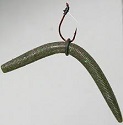 It’s been nine years since Michael Iaconelli caught the heaviest bass of his life, 14 pounds, one ounce, but the Yamaha Pro has never forgotten the excitement of that catch, or the way he caught it. The big fish hit a wacky rig, a finesse-type presentation with a plastic worm, light spinning tackle, and thin line.
It’s been nine years since Michael Iaconelli caught the heaviest bass of his life, 14 pounds, one ounce, but the Yamaha Pro has never forgotten the excitement of that catch, or the way he caught it. The big fish hit a wacky rig, a finesse-type presentation with a plastic worm, light spinning tackle, and thin line.
“I’ve been fishing a wacky rig for more than 25 years and always have a rod and lure rigged and ready, no matter where I’m fishing,” notes Iaconelli, recognized as one of the best light tackle anglers in professional tournament competition. “Wacky rigging is one of the most productive of all finesse techniques, and also one of the easiest to use.
“It’s absolutely one of the very best presentations for spawning fish right now in the spring, but it works all year. I’ve used a wacky rig to catch bass in the Delaware River with water temperatures as low as 40 degrees.”
A wacky rig consists of a four to six-inch soft plastic stick worm rigged weightless but with the hook inserted through the middle of the worm rather than at one end. Rigging this way allows both ends of the lure to vibrate and wiggle as the stick worm falls, a life-like action bass find hard to resist.
Regular plastic worms can also be rigged through the center and fished this way, acknowledges Iaconelli, but stick worms produce better action because they have basically the same diameter from end to end, rather than being tapered like other worms. They’re also slightly heavier, which also increases vibration as the lure falls.

“Basically, all I do is cast and let the wacky rig fall on a semi-slack line, and if I don’t get a strike on the initial fall, I raise my rod to lift the lure off the bottom, then let it fall again,” explains the Yamaha Pro. “When I fish a wacky rig weightless, I seldom fish it more than 10 or 12 feet deep, but I have used weighed hooks and fished as deep as 25 feet.
“It’s all about creating multiple falls to take advantage of the unusual action. This is not a dragging technique at all. Sometimes I will shake a wacky rig while it’s on the bottom, but only for a moment.”
Special weighted hooks, generally known as “wacky hooks,” are available for wacky rigging in deeper water, as are small rubber 0-rings that can be slipped over the stick worm to hold the hook in place. Both are available at leading fishing tackle outlets.
“The best time to fish a wacky rig is during the spawning season and in clear water,” says Iaconelli, who was doing just that when he caught the 14-1. He was practicing for the very first Bassmaster® Elite series tournament at Lake Amistad in 2006 and after weighing the big bass, he released it in hopes of catching it again during actual competition. Of course, he never did.
“Wacky rigs are not weedless lures, unless you use hooks with wire weed guards,” adds Iaconelli, “but you can still cast them close to cover like flooded brush, stumps, boat docks, and even vegetation. Lake Amistad is filled with flooded brush, and this is where I caught the big bass.
“It immediately dived into some brush and I really thought I’d lost it until I got close enough to see it in the clear water. I fish a wacky rig on 10 pound fluorocarbon line and a limber spinning rod so I get the most action possible from the lure, and I feel very fortunate to have landed that bass.”
Finesse fishing is all about creating a more natural lure presentation, concludes the Yamaha Pro, and a wacky rig offers not only a natural action, but also an action unique among soft plastic lures. With both ends of the bait shaking and vibrating as the worm falls, it’s no wonder bass like Iaconelli’s 14 pound giant go after it.

